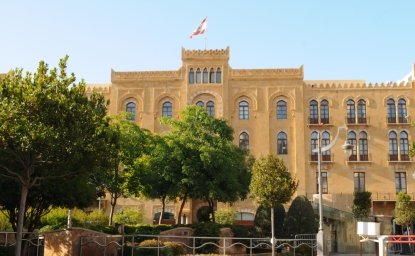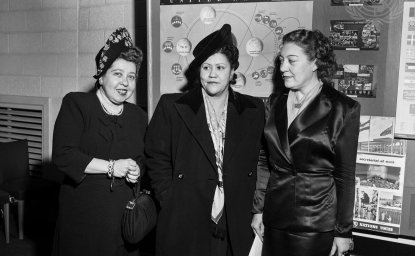MENA Women Quarterly Report (October-December 2016)


Feature: Women’s Attire
Although controversy over women’s clothing in the Middle East is not a new topic, it was a focal point of many news articles throughout the past quarter. During the past few months, some governments in the region have jailed women because of infractions against legally mandated attire. In December, Saudi police officers detained a woman after she removed her abaya in public. According to a Saudi newspaper, the young woman announced her plans on social media prior to the incident. Also in December, twelve Iranian fashion industry workers were arrested for “spreading prostitution” because of photos that were posted online that spread a “Western-style culture of nudity.” These governmental positions on women’s attire, while significant and consequential, cannot compare to ISIS’s strict dress code for women and the severe punishment women receive for any deviation, which the New York Times detailed in a recent article. Elsewhere in the region, Turkey lifted the ban on headscarves for women in the military in November, which mirrored the shift in August that allowed policewomen to wear headscarves.
As long as discussions about women’s clothing have been going on, so too, have women’s efforts to resist or address imposed dress codes. There were several recent examples of such efforts, including a group of women working as aides in the Israeli parliament who protested after being denied entry because their skirts were too short, according to the Knesset’s dress code. In Egypt, women are wearing 1960s-style dresses to combat sexual harassment as part of an initiative called “Dresses of the Past When Our Streets Were Safe” that seeks to normalize such clothing for women. Elsewhere, women in Qatar are working within the country’s social conventions to launch a modest sportswear line to provide women with more opportunities to be active.
Women in the Economy
Several articles from the past few months highlighted the importance of equal participation of women in the workforce. In December, Hurriyet reported on a study—carried out by McKinsey & Company and the Turkish Industry and Business Association—that found Turkey’s gross domestic product (GDP) could expand by 20 percent by the year 2025 if women’s participation in the workforce increased from 30 percent to 63 percent. It is likely Turkish President Recep Tayyip Erdogan would support such an increase in women in the workforce: in a speech he gave in November, he stated “strength cannot be acquired through isolating women,” and “women should be present in every sector of society,” arguing this is the reason many Western economies are stronger than the Turkish economy. Similarly, Jordan’s Deputy Prime Minister for Economic Affairs Jawad Anani recently articulated his belief that increasing women’s participation in the workforce also increases “the quality and size” of GDP.
Articles from the last three months also reported on initiatives and policies enacted to bolster women’s participation in the economy. In October, the Thompson Reuters Foundation reported the Oman Development Bank funded over 6,000 women’s entrepreneurship projects—totaling $54 million—during an eight-year period ending in September 2016. Additionally, the Palestinian Ministry of Labor and the National Committee for Women’s Employment, in conjunction with the Palestinian General Federation of Trade Unions, published the “Guideline for Women’s Employment Rights,” which aims to “instill equality and social justice, eliminate gender-based discrimination at the workplace, improve the work environment, and raise women’s awareness of their rights.” In the UAE, the International Centre for Biosaline Agriculture launched the Young Arab Women Scientists Leadership programme to help more women become farmers, a sector in which women are under-represented.
Other stories focused on women working in unusual or unprecedented positions. In Jordan, women in the last few months have expanded an all-women fleet of “pink taxis” and obtained licenses to become plumbers. Women first-aid workers in Gaza were assigned to respond to medical issues at the football Premier League for the first time. In the UAE, women now comprise 20 percent of workers in the nuclear sector—an unprecedented number for that industry. Women in Saudi Arabia finally have the right to work in pharmacies, as long as the businesses only have all-female staffs. Additionally, both a senior Saudi cleric and a Saudi health ministry official argued that women should be allowed to work as paramedics and opticians—professions from which women are currently barred.
Despite the progress for some women, other women in the region face setbacks in the economy. A survey conducted by Oxford Strategic Consulting discovered that 36 percent of Qatari organizations either “never or sometimes actively promote female nationals as part of their strategy” for Qatarization (the policy to shift labor from expatriates to Qatari nationals). Lastly, the Turkish government recently shut down the first all-women Kurdish news agency among its forced closures of media outlets throughout the country.
Human Rights
During the past quarter, there were a number of news articles about women’s arrests for activism and other legal rights concerns. In October, Iranian Golrokh Ebrahimi Iraee received a six-year jail sentence for writing “an unpublished fictional story about stoning to death in her country.” More recently in Iran, the head of the Women’s Basij militia “reportedly called the promotion of gender equality illegal” and indicated that women’s rights activists should be persecuted. Egyptian authorities did just that with the December arrest of feminist and women’s rights activist Azza Soliman, who founded the Centre for Egyptian Women’s Legal Assistance (CEWLA). A recent article also profiles Saudi women’s rights activist Souad al-Shammary who was arrested in 2014 for “agitating public opinion” and held for three months without charge.
Numerous articles over the past several months have covered other ongoing legislative issues in the MENA region. Some of these bills have improved women’s rights while others have further deteriorated the status of women. In November, the Turkish government withdrew a proposed bill that “could have overturned men's convictions for child sex assault” after considerable public protest. In December, a Lebanese Administration and Justice Committee voted to abolish Article 522, the so-called “rape law,” which had permitted rapists to marry their victims in order to avoid punishment. The same committee is working on a draft law to present to parliament. A court in Tunisia—which introduced a similar bill in 2014 that has yet to be discussed in parliament—recently approved the marriage between a pregnant 13-year-old and her 20-year old relative; with this move, the man is able to avoid a possible sentence of six years in prison. In the past few months, the Egyptian parliament has considered controversial bills related to child custody and adultery. And in Jordan, activists continue to demand reforms to the country’s penal code because of honor killings, which increased significantly in 2016.
Along with some of these constructive legal developments, there were other positive stories for women in the region. To help address the issue of honor killings in Jordan, the government plans to build a shelter for women “whose lives are in danger for reasons related to ‘family honour.’” Saudi Arabia recently held a two-week campaign that encourages victims of domestic violence to report abuse to a 24/7 hotline run by the Ministry of Social Affairs. An Egyptian documentary about sexual violence received an award at the San Francisco Arab Film Festival 2016, and Egyptian women who experience sexual harassment are reporting incidents to police more frequently according to local NGOs.
Women in Public Service
The outcomes of several elections in the Middle East during the last quarter had mixed results for women’s representation. October’s parliamentary elections in Morocco caused women’s representation in the legislature to increase from 17 to 21 percent. Moreover, Moroccans elected 10 more women to the parliament than dictated by the quota of 71 women parliamentarians. In Kuwait however, only 1 of the 15 women who ran for a seat in the country’s 50-person legislature received enough votes to become a parliamentarian. In late December, Omanis voted for candidates to join the Municipal Council; seven women were elected, which is an increase from the four who won in the 2012 elections. Additionally, women will exclusively represent one of Oman's provinces on the council, which is unprecedented for the Sultanate. Looking ahead, Egypt is aiming to increase the number of women in public service; the National Council for Women announced it was in the midst of training 12,000 women to run in local council elections.
Women also had mixed success obtaining appointed public service positions during the last several months. In Morocco, 13 women were sworn in as ambassadors to positions around the world, one of whom will be Morocco’s first woman ambassador to the United States. In Israel, two women from the Ethiopian-Israeli community were appointed to serve as judges, a first for their community. Women are also being appointed to senior security posts in the MENA region; in Kuwait, women can now serve on the National Assembly’s security force and for the first time a woman is in charge of an Omani police station. However, there have been some setbacks for women seeking appointed positions: Libyan women MPs have demanded more representation in parliamentary delegations, Iranian women activists have criticized President Hassan Rouhani for the lack of women in his cabinet, and Lebanon’s first women’s affairs minister will be a man.
It should be noted that women’s representation in public service does not always guarantee the expansion of women’s rights. In December, Mounia Meslem—Algeria's Minister of National Solidarity, Family, and Women’s Affairs—argued married working women should give their salaries to the national treasury to alleviate Algeria’s financial woes.
Women in Conflict Situations
In the past few months, there were relatively few stories about women in conflict situations—some about women being held by ISIS, some about the situation for women in Syria, and one about how the ongoing conflict in Yemen has affected women. In October, dozens of Yazidi women who had been taken by ISIS in 2014 were transferred from Mosul, Iraq to Raqqa, Syria because of Iraqi-led efforts to recapture Mosul from ISIS. Another article detailed one family’s search for their “Lost Girl,” a three-year-old who was taken by ISIS two years ago. In Syria, a seven-year-old girl, Bana Alabed, captured international attention as she tweeted about life in Aleppo. Her account went silent as bombing of the city continued, until she and her family were evacuated in mid-December and welcomed in Turkey. The BBC captured the plight of displaced Yemeni women and girls in a recent photo collection.
While news about women being held in ISIS-controlled territory has declined, there have been more articles about survivors who escape with most reports describing how numerous challenges remain post-ISIS. One article described the ordeal of a group of women who were captured and held as slaves by ISIS in Sirte, Libya and how after their escape they were accused of being ISIS sympathizers and imprisoned. Other reports underscored the trauma that persists even after escaping from ISIS and the aftermath of young girls being married off to save them from ISIS. The impact of child marriage is also evident for Syrian girls at the Zaatari refugee camp in Jordan, where the rate of child marriages more than doubled to 25 percent in 2013, according to UNICEF.
Even with these articles on the continual difficulty for women in conflict zones, there were some positive stories from the past quarter to note. Nadia Murad, a Yazidi woman who escaped ISIS, received the Vaclav Havel Human Rights Prize in October after being named a UN Goodwill Ambassador in the previous month. News of an all-female Yazidi militia fighting ISIS was joined by an increase in the number of women in Iraq’s Popular Mobilization Units, which has reached around 3,000. Women volunteers in Turkey are supporting and helping Syrian refugees as the “solely-women initiative for Syrian refugees.”
Authors



Middle East Program
The Wilson Center’s Middle East Program serves as a crucial resource for the policymaking community and beyond, providing analyses and research that helps inform US foreign policymaking, stimulates public debate, and expands knowledge about issues in the wider Middle East and North Africa (MENA) region. Read more

Explore More
Browse Insights & Analysis
MENA Women Quarterly Report

MENA Women News Brief: August 1 - August 15, 2018

Women are the Catalysts for Change in Lebanon
